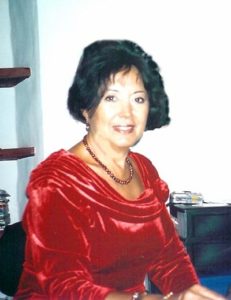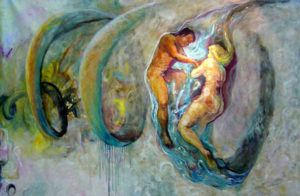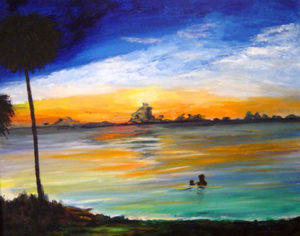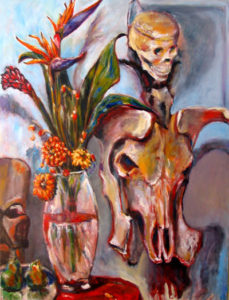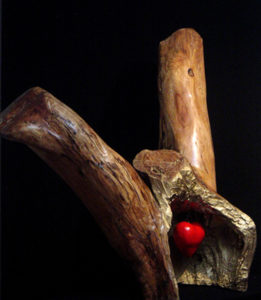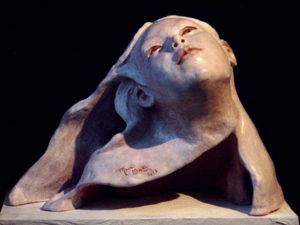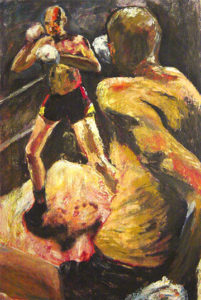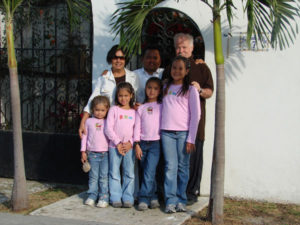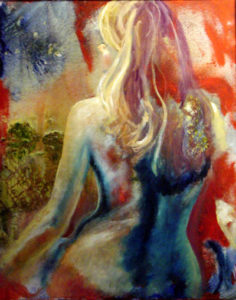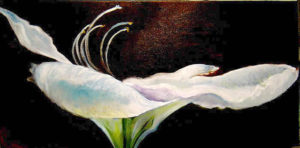Exploring Mexico’s Artists and Artisans
“I like to see the human body as the work of my Higher Power, who I choose to call God,” says artist Mara Odette. “I not only like to paint nudes, but also faces and gestures because the expressions in a face or in a body tell a lot more than words.” An attentive observer, Odette has long studied the human condition, as life itself is the theme that occurs most frequently in her artwork. For example, Odette’s mural “The Dance of the Genes” explores the subject of DNA and how it binds the human race together.
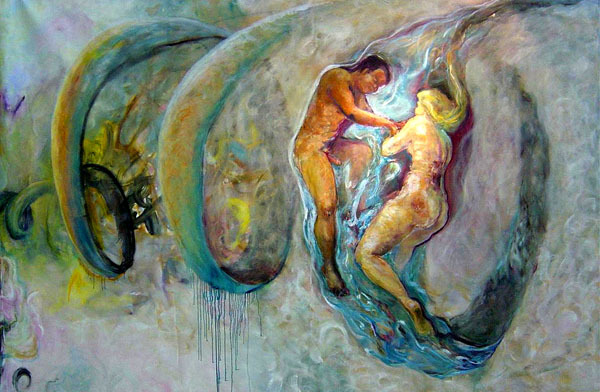
“It is fascinating to think of all the complexity, the miraculous ellipses of DNA,” the artist writes of the mural on her website. “The whole human race dwells in my blood! I am Indian, Caucasian, Black, Brown and Yellow, and who knows what other circumstances in the fascinating impulses of life.”
One of the focal points of the mural is a brown-skinned man clasping the hands of a white-skinned woman. The naked couple appears to be dancing and their energy bound together with the double helix form of DNA.
The artist explains how the examination of her own family led her to contemplate the similarities of the human race as a whole.
“As a result of marriages to non-Mexicans, we have members of the family (who) are very tall, very short… a little bit darker, a little bit lighter, and so on, which makes our family reunions like an assembly at the United Nations,” Odette says, pointing out that even though everyone looks different in her family, they are all alike in that they have loving relationships with each other.
“That is what made me realize that we have a lot more similarities than what my eyes can see,” the artist explains, noting that her family’s situation is a global phenomenon that is occurring across the world, as all different cultures and people continue to mix and create a more diverse society.
Interestingly, Odette’s very first commission involved drawing and painting people from across the globe for her Mexico City elementary school’s “World Map” mural. “For several weeks, I arrived at my classroom and (at) a separate table, dedicated all day to painting.” Odette recounts.
From this early experience with the arts, Odette went on to focus on poetry and performance. She represented her elementary and secondary schools, her university and even her country of Mexico in various poetry recitals, and later performed on radio and television. It would not be until many years later, however, that Odette would return to painting.
“It was not until 1985 when I rediscovered the joy of painting, due to my friendship with the artist Maureen Berkowitz,” Odette recalls. When the two struck up a friendship, Odette began painting in the Washington, DC studio of the artist and her husband, Color Field pioneer Leon Berkowitz, who died in 1987.
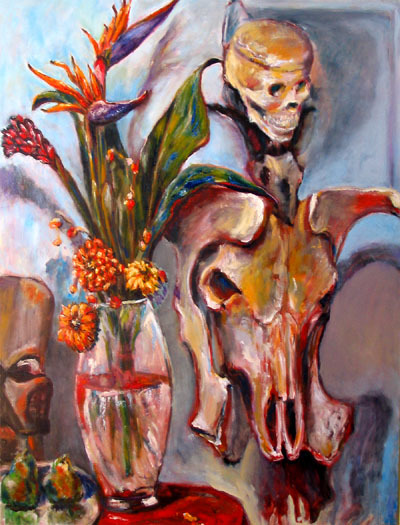
This return to the canvas invoked a long dormant passion in Odette, who has since fully embraced the act of artistic creation. “I do not feel or think my age of 60; rather, I feel like a ‘rising star’ who is just now starting to really taste the full enjoyment of creating art,” she says.
And her artistic vision knows no bounds, as Odette’s paintings have grown to encompass whole walls, like her piece “The Dance of the Genes.” This oil on canvas mural is comprised of three panels that measure 2 x 6 yards each, thus spanning 18 yards when displayed together. And according to the artist, the mural may expand in the future, as she is thinking about developing it further.
“I paint murals because they allow me to use my arms, legs and all my gestures to express myself,” Odette notes. “If I have good music, and I always do when I paint, I can create a dance or an opera between my thoughts and the wall — or the canvas attached to the wall.”
Odette’s paintings take anywhere from two hours to several years to complete and are created with charcoals, acrylic and oils. She sometimes mixes in other materials as well, including sand, paper, shells, jewelry, seeds and stones.
In addition to paintings, Odette also creates sculptures that are made of clay, wood, papier-mâché and mixed media. “I also use found objects that fit in with my ideas. Or on occasion, the found objects themselves give me ideas about how to use them,” the artist notes. Sculptures take her anywhere from between 15 hours to six months to complete. And there is one mixed media sculpture that she adds to every year, so it is a continual work in progress.
Regardless of the piece on which she is working, the creative process is always the same for Odette. “It is like a rehearsal of a concert or a particular dance or the construction of a speech that I have to keep working on until it is clearly expressed — even if it is only clear to me,” the artist says.
“Every medium has its own characteristics and its own limitations, but all allow me to express the mood I am in and my reaction to the subject I am working on,” Odette explains.
Many times, the subjects of her work are human in nature, even if not always human in form. For example, the paintings that comprise her Lifescapes series are primarily figurative paintings that include landscapes and seascapes, but are “are always related to human life experiences,” according to the artist. “Even if I see a landscape or a flower or the ocean, I can detect a human feeling, so it reminds me (that) I am human,” Odette explains.
One especially memorable piece that perfectly illustrates Odette’s ability to infuse any of her subjects with a human essence is “An Inside Job.” This sculpture, which is comprised of part of a tree with a bright red heart hanging from its center, has a touching story behind it.
“After being absent for several years and having my house rented out, I returned to find that the beautiful tree that gave me so many flowers for so many years had nearly died and I had to cut it down,” the artist recounts. “In looking at the dying tree, it was impossible to cut it further because I saw (that) its shape was begging me to let it emerge. So I decided to clean it, apply gold leaf to its insides and replace its heart for a clay one.”
This experience and so many others in Odette’s life have served as powerful inspirations for her artwork.
Throughout her life, she has traveled extensively, which has opened her eyes to all different cultures and experiences. Her forays across the globe with her late husband involved living in a myriad of different places — from South, Central and North America to Europe and Asia.
These days, Odette is living in the United States with her second husband, Rick Williams, who is also an artist. The two currently reside in Maryland, but have established a studio in Cuernavaca, Mexico and are planning to open a US-based studio and art gallery in Williams’ hometown of Buffalo, New York.
“Soon, we will be working either in Cuernavaca, Buffalo or wherever our art takes us,” Odette says.
Odette has been crossing the border between Mexico and the United States for years, as her son, daughter-in-law and granddaughters live in the United States, while other relatives reside in Odette’s birthplace of Chiapas, Mexico.
Back in 2003, Odette was given the chance to hold a traveling exhibit in Chiapas that was sponsored by Coneculta, the Chiapas State Council for Culture and the Arts. The first stop was at the Centro Cultural de Chiapas Jaime Sabines (Jaime Sabines Chiapas Cultural Center) in Tuxtla Gutiérrez and, after a month, the exhibit moved on to several other museums in Chiapas, including the Museo de Culturas Populares (Popular Cultures Museum) in San Cristóbal de Las Casas, which is located just a few blocks from the house where Odette was born.
“All of this sounds like a fairytale, but it is true, it really happened to me,” says Odette of this significant event in her life. “I experienced the love of my family and the love of my people, right there in the land of my ancestors.”
It was like coming full circle for a woman who has spent years straddling two cultures – the one of her birth country and the one of her adopted homeland.
“Going back and forth, as I do, expands my horizons,” Odette notes. “It gives me more ideas to express, although I never seem to have enough time to express them.”
As Odette points out, Mexico and the United States are two countries “with so many controversial issues of love and hate relationships. They increase their number of air flight transportations, while at the same time building physical and psychological walls, pretending to have more than .01% DNA difference.”
But Odette hopes that art can help to unite these two countries, as well as all the others across the globe.
“Art is the only means to raise the spirit; it creates an instant message and does not need a language or idiom to be understood. Art may convert animal instincts into meditating thoughts, stop massacres and create hope.”

